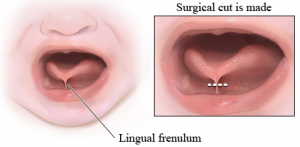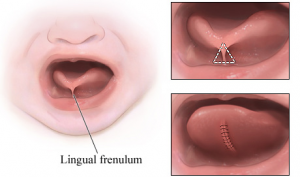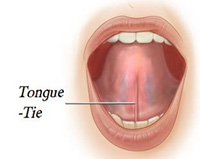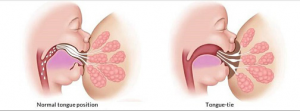A. What is Tongue Tie Release?
Tongue tie is a relatively common finding affecting up to about 10% of newborns. There is much interest in the potential impact that a tongue tie may have on a baby’s feeding and there appears to be a recent trend for early treatment.

A tongue tie is a membrane/band of tissue that extends from the undersurface of the tongue to the floor of the mouth. It is formed as part of the normal development of the tongue and provides direction for the forward direction of growth of the tongue. Normally the membrane disappears but in some instances it persists as a tongue tie.
B. How is it Done?
Dividing a tongue tie in an awake baby is a very different scenario than carrying out under general anesthetic. In an awake baby the division is only a simple snip through the membrane, whilst under general anesthetic the division is carried out down to the muscles of the tongue and the incision is closed in the opposite direction (frenuloplasty) to minimize rescarring.

In our hospital the tongue tie division is carried out by a Consultant Surgeon assisted by a Paediatric nurse using good illumination and sterile instruments. Despite what is reported, the procedure is uncomfortable for the baby but the discomfort settles fairly quickly once the baby is breastfed. Breast feeding itself appears to have an analgesic effect and babies settle within a few minutes.
C. Why Tongue Tie Release?
It is unusual for a tongue tie to have an impact on speech and as most stretch over time it is impossible to predict the potential impact on future speech development in a baby with a tongue tie. In older children it may become clearer that the tongue is restricting movement causing speech issues. This may not simply be the inability to protrude the tongue to beyond the teeth but also a restriction in side movements and rolling the tongue back against the palate causing slurring of speech and difficulty with pronouncing the letter “r.”

Later in life a tongue tie can restrict the ability to lick ice cream, kiss and play wind instruments. It is also thought that a tongue tie may cause a gap between the lower incisors but this is unusual.
D. Preparation for Tongue Tie Release
In babies less than 12 weeks division of a tongue tie (frenectomy) can be carried out without the need of a general anesthetic. However in older infants it is best to have the procedure carried out under a general anesthetic
E. Reasons & benefits of Tongue Tie Release
If your baby is having difficulty latching on and it is uncomfortable to breast feed then dividing the tongue tie is likely to make a difference. For those babies who can latch on but are fussy and appear to have a lot of “wind” the decision to divide a tongue tie is not always so straightforward and it is helpful to take the advice of a lactation consultant.
F. Risks of not undergoing Tongue Tie Release
Most tongue tie’s do not cause any difficulty and stretch over time. However a tongue tie may affect a baby’s ability to breastfeed causing difficulty with latching on. This can result in nipple discomfort for the mother and some babies will struggle to feed leading mothers to switch to bottle feeding.

It is also thought that babies with a tongue tie will swallow air causing them to have a lot of “wind” and abdominal discomfort.
G. Complications from Tongue Tie Release
Complications following tongue tie division are unusual. There is a potential risk of bleeding, infection and inadvertent damage to the submandibular ducts (these are tubes that drain saliva under the tongue). The infection may be local at the site of division but may also result in an infection within the lymph nodes in the neck that drain the area under the tongue. There is also a chance of the tongue tie reforming as it heals and this is usually dependant on how much is divided. We believe that by using sterile instruments, carrying out the procedure in a clinic environment with Pediatric trained nurses and surgeons these risks are minimized.
H. What happens after Tongue Tie Release
Most babies will latch on quickly after having the tongue tie divided. However some mothers may wish to have the support of lactation consultant over the few days after the tongue tie division.
I. Consent for Tongue Tie Release
By giving consent you are giving authorization for the patient to undergo Tongue Tie Release after understanding the need, risks and benefits of the procedure. You are encouraged to ask and have your questions answered before consenting. Although due professional care will be taken, no guarantee has been made regarding the outcomes.
By refusing to consent you signify that although a request for your consent has been made and all explanations given, you have made an informed choice not to undergo Tongue Tie Release and therefore absolve the doctor and hospital of any liability with regard to the outcomes.
J. Can I ask a question?
It is ok to ask questions relating to the procedure and its outcomes at any time. You may ask any member of the team taking care of you for any clarification you need. Should they deem it fit, they may consult other team members so that the best possible answers to your questions are availed. You can also request for a second opinion should you feel like having one.

